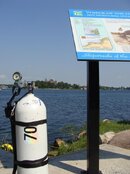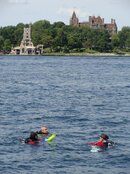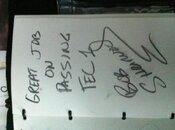ScubaFeenD
Contributor
The following is a class report for GUE Technical Diver Level 1 class taken with Bob Sherwood (and Karim Hamza, Errol Kalayci, and Fraser Purdon) at the St Lawrence River. I was so impressed that I will try an provide a description of the class, some pictures, and a comparison to other technical training I have taken.
Prior to Class: I had had some sport trimix training this previous January which got me used to technical diving concepts and allowed me to get some Tech 1 level dives in prior to class. I had taken the class and enjoyed it, but now realize that there is so much more to learn.
Day 0: A few weeks prior to class Bob, me, and my teammates met at our local quarry (Dutch Springs) to get some of the formalities out of the way and to talk more about logistics, since getting oodles of Trimix up to the American side of the St Lawrence (which barely has nitrox) was going to be a huge endeavor. It was at this time that we learned that Karim Hamza, Fraser Purdon, and Errol Kalayci would be there to assist for different GUE organizational reasons (which I prefer not to go into here). So logistics would be especially complicated/important considering there would be not only the three students, but also bob, and a filmographer, two other GUE instructors and one intern. You read that right, there would be 7-8 people there diving at any given time.
After we talked we got in the water and started with the Swim tests, and the followed up wtih 2.5 hours learning and practicing the toxing diver rescue over and over. The team had a mix of big and small people to practice on with a variety of tanks. One of my buddies (who I aptly nicknamed sasquatch) also likes to wear HP130s. Needless to say he was heavy and we all learned an extremely valuable lesson regarding the need for a balanced rig when my 40lb wing wouldn’t lift the both of us during my stint as victim and his position as rescuer. The Balanced Rig is so hugely important for so many reasons, and after practicing a bit the toxing diver rescue became pretty easy on anyone.
--Intermission while attending the Brockville Invasion with the Blanchard/Canadian crew—

Prior to Class: I had had some sport trimix training this previous January which got me used to technical diving concepts and allowed me to get some Tech 1 level dives in prior to class. I had taken the class and enjoyed it, but now realize that there is so much more to learn.
Day 0: A few weeks prior to class Bob, me, and my teammates met at our local quarry (Dutch Springs) to get some of the formalities out of the way and to talk more about logistics, since getting oodles of Trimix up to the American side of the St Lawrence (which barely has nitrox) was going to be a huge endeavor. It was at this time that we learned that Karim Hamza, Fraser Purdon, and Errol Kalayci would be there to assist for different GUE organizational reasons (which I prefer not to go into here). So logistics would be especially complicated/important considering there would be not only the three students, but also bob, and a filmographer, two other GUE instructors and one intern. You read that right, there would be 7-8 people there diving at any given time.
After we talked we got in the water and started with the Swim tests, and the followed up wtih 2.5 hours learning and practicing the toxing diver rescue over and over. The team had a mix of big and small people to practice on with a variety of tanks. One of my buddies (who I aptly nicknamed sasquatch) also likes to wear HP130s. Needless to say he was heavy and we all learned an extremely valuable lesson regarding the need for a balanced rig when my 40lb wing wouldn’t lift the both of us during my stint as victim and his position as rescuer. The Balanced Rig is so hugely important for so many reasons, and after practicing a bit the toxing diver rescue became pretty easy on anyone.
--Intermission while attending the Brockville Invasion with the Blanchard/Canadian crew—








